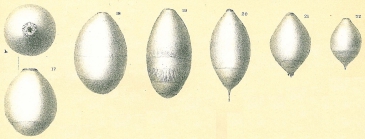
| Introduction | | Search taxa | | Taxon tree | | Taxon match | | Checklist | | Literature | | Stats | | Photogallery | | OBIS Vocab | | Log in |
CaRMS taxon detailsGlandulina ovula d'Orbigny, 1846
417888 (urn:lsid:marinespecies.org:taxname:417888)
accepted
Species
marine,
recent + fossil
Orbigny, A. D. d'. (1846). Die fossilen Foraminiferen des tertiären Beckens von Wien. Foraminifères fossiles du bassin tertiaire de Vienne. 312 p., available online at https://archive.org/details/bub_gb_JKpAAAAAcAAJ
page(s): p. 29 pl. 1 fig. 6, 7 [details]
Hayward, B.W.; Le Coze, F.; Vachard, D.; Gross, O. (2021). World Foraminifera Database. Glandulina ovula d'Orbigny, 1846. Accessed through: Kennedy, M.K., L. Van Guelpen, G. Pohle, L. Bajona (Eds.) (2021) Canadian Register of Marine Species at: http://www.marinespecies.org/CaRMS/aphia.php?p=taxdetails&id=417888 on 2024-04-19
Nozères, C., Kennedy, M.K. (Eds.) (2024). Canadian Register of Marine Species. Glandulina ovula d'Orbigny, 1846. Accessed at: https://www.marinespecies.org/carms/aphia.php?p=taxdetails&id=417888 on 2024-04-19
original description
Orbigny, A. D. d'. (1846). Die fossilen Foraminiferen des tertiären Beckens von Wien. Foraminifères fossiles du bassin tertiaire de Vienne. 312 p., available online at https://archive.org/details/bub_gb_JKpAAAAAcAAJ
page(s): p. 29 pl. 1 fig. 6, 7 [details] context source (Deepsea) Intergovernmental Oceanographic Commission (IOC) of UNESCO. The Ocean Biogeographic Information System (OBIS), available online at http://www.iobis.org/ [details] basis of record Sen Gupta, B. K.; Smith, L. E.; Machain-Castillo, M. L. (2009). Foraminifera of the Gulf of Mexico in Felder, D.L. and D.K. Camp (eds.), Gulf of Mexico–Origins, Waters, and Biota. <em>Biodiversity. Texas A&M Press, College Station, Texas.</em> 87-129. [details] Available for editors additional source Papp, A. and Schmid, M.E. (1985). The fossil foraminifera of the Tertiary Basin of Vienna. Revision of the monograph by Alcide d'Orbigny (1846). <em>Abhandlungen der Geologischen Bundesanstalt.</em> 37, 311 p., available online at https://opac.geologie.ac.at/ais312/dokumente/AB0037_001_A.pdf page(s): p. 21 [details] Available for editors  Present Present  Inaccurate Inaccurate  Introduced: alien Introduced: alien  Containing type locality Containing type locality
From editor or global species database
Synonymy Papp and Schmid (1985) put into synonymy the specimens of G. laevigata and G. ovula described by d'Orbigny from the Vienna Basin but not the species described in 1826:"Glandulina laevigata d'ORBIGNY (non 1826) Plate 2, figs. 1-6 Valid name: Glandulina ovula d'ORBiGNY 1846 Glandulina laevigata d'ORBIGNY; p. 29, Plate 1, figs. 4,5 Reference material: GBA Nr. 1977/01/3 L o c a l i t y : Baden Rem.: Glandulina laevigata d'ORBiGNY 1826 (recent) has a distinctly biserial earlier portion of the test. In G. laevigata d'ORBiGNY 1846 the biserial test is largely reduced. Specimens corresponding to the typical G. laevigata have not been described from the Vienna Basin. Under G. laevigata d'ORBiGNY understands glandulines from the clay facies of Baden. This is also confirmed by the material from vial Nr. 3. The test is glassy, thin-shelled and broad. Vial Nr. 4 (G. ovula) contains more thickshelled, larger forms which, according to their state of preservation, originate from marl and sand facies of Nußdorf- Kahlenberg. Four specimens from vial Nr. 4 originate, according to their state of preservation, from Baden. They display the same dimensions as the large specimens from Nußdorf. Data on test dimensions reveal an overlapping of the associations from the clay and marl facies (Fig. 1). Although morphological differences between the extremes are quite distinct, in our opinion significant groups do not emerge; we therefore unite the two species G. laevigata and G. ovula, differentiated by d'ORBiGNY, and retain G. ovula as the valid name. In complete specimens the aperture is radiate, yet closed; the pores are relatively small (compare Plate 2, fig. 6)." [details] |

